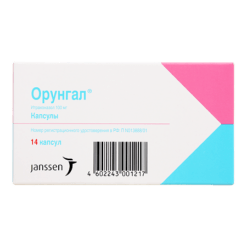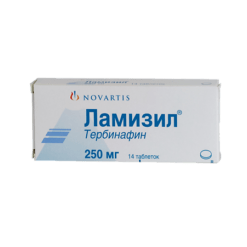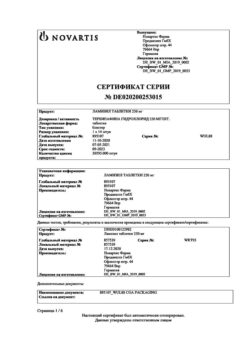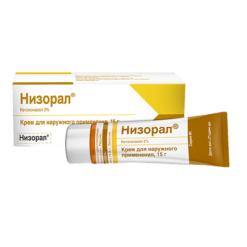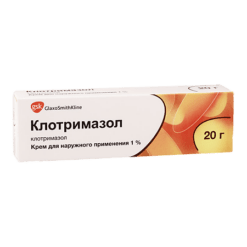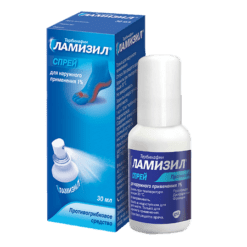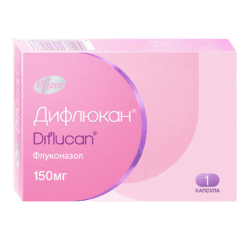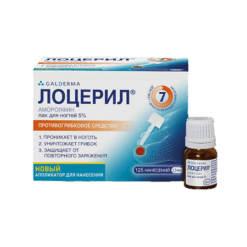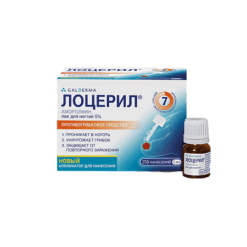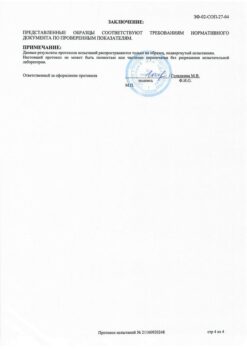No products in the cart.
Fluconazole Sandoz, 150 mg capsules
€4.84 €4.31
Description
Pharmacodynamics
Antifungal agent, has a highly specific action by inhibiting the activity of cytochrome P450-dependent fungal enzymes. It blocks conversion of fungi cells lanosterol into membrane lipid – ergosterol; increases cell membrane permeability, disrupts cell growth and replication.
Fluconazole is highly selective for cytochrome P450 of fungi, it actually does not inhibit these enzymes in humans (in comparison with itraconazole, clotrimazole, econazole and ketoconazole it inhibits cytochrome P450-dependent oxidative processes in human liver microsomes to a lesser extent).
It is active against opportunistic mycoses, including those caused by Candida spp. (including generalized candidiasis against immunosuppression), Cryptococcus neoformans and Coccidioides immitis (including intracranial infections), Microsporum spp. and Trichophyton spp; in endemic mycoses caused by Blastomyces dermatidis, Histoplasma capsulatum (including immunosuppression).
Pharmacokinetics
After oral administration fluconazole is well absorbed, its bioavailability is 90%. Maximum concentration after oral administration on an empty stomach of 150 mg of the drug is90% of the plasma concentration when administered intravenously at a dose of 2.5-3.5 mg/l.
Concurrent intake of food has no effect on absorption of fluconazole taken orally. Time of maximum concentration after oral administration on an empty stomach of 150 mg of the drug is 0.5-1.5 hours. Concentration in plasma is in direct dependence on the dose.
The 90% level of equilibrium concentration is reached by 4-5 days of the drug treatment (when administered once daily). The “shock” dose (on the first day), twice as much as the usual daily dose, allows reaching the level of concentration corresponding to 90% of the equilibrium concentration by the second day.
The volume of distribution is close to the total body water content. Binding with blood plasma proteins is 11-12%. Fluconazole penetrates well into all body fluids. Concentration of active substance in breast milk, joint fluid, saliva, sputum and peritoneal fluid is similar to that in plasma.
Constant values in vaginal secretion are reached 8 hours after oral administration and maintained at this level for at least 24 hours. Fluconazole penetrates cerebrospinal fluid (CSF) well, in fungal meningitis the concentration in CSF is about 80% of its level in plasma.
In sweat fluid, epidermis and stratum corneum (selective accumulation) concentrations exceeding serum concentrations are achieved. On day 7 after oral intake of 150 mg fluconazole its concentration in stratum corneum is 23,4 mcg/g, 1 week after the second dose – 7,1 mcg/g. Concentration of fluconazole in healthy nails after 4 months of use in a dose of 150 mg once a week is 4.05 µg/g and 1.8 µg/g in affected nails.
It is an inhibitor of CYP2C9 isoenzyme in liver. No fluconazole metabolites were found in peripheral blood.
It is excreted mainly by the kidneys (80% – unchanged, 11% – as metabolites). Half-life of fluconazole is about 30 hours. Fluconazole clearance is proportional to creatinine clearance. After haemodialysis for 3 hours, plasma concentration of fluconazole decreases by 50%.
Indications
Indications
Cryptococcosis, including cryptococcal meningitis and other localizations of this infection (including lungs, skin), both in patients with a normal immune response and in patients with various forms of immunosuppression (including AIDS patients, organ transplants); the drug can be used to prevent cryptococcal infection in patients with AIDS;
candidiasis of the mucous membranes, incl. oral cavity and pharynx (including atrophic candidiasis of the oral cavity associated with wearing dentures), esophagus, non-invasive bronchopulmonary candidiasis, candiduria; prevention of relapse of oropharyngeal candidiasis in patients with AIDS;
genital candidiasis: vaginal candidiasis (acute and chronic recurrent); prophylactic use to reduce the frequency of relapses of vaginal candidiasis (3 or more episodes per year); candidal balanitis;
generalized candidiasis, including candidemia, disseminated candidiasis and other forms of invasive candidal infections (infections of the peritoneum, endocardium, eyes, respiratory and urinary tract). Treatment can be carried out in patients with malignant neoplasms, patients in intensive care units, patients undergoing cytostatic or immunosuppressive therapy, as well as in the presence of other factors predisposing to the development of candidiasis;
mycoses of the skin, including mycoses of the feet, body, and groin area; pityriasis versicolor (varicolored) lichen, onychomycosis and skin candidiasis infections;
deep endemic mycoses, including coccidioidomycosis, paracoccidioidomycosis, sporotrichosis and histoplasmosis in patients with normal immunity;
prevention of fungal infections in patients with malignant neoplasms who are predisposed to such infections as a result of chemotherapy with cytostatics or radiation therapy.
Pharmacological effect
Pharmacological effect
Pharmacodynamics
An antifungal agent that has a highly specific effect, inhibiting the activity of fungal enzymes dependent on cytochrome P450. Blocks the conversion of lanosterol from fungal cells into membrane lipid – ergosterol; increases the permeability of the cell membrane, disrupts its growth and replication.
Fluconazole, being highly selective for fungal cytochrome P450, practically does not inhibit these enzymes in the human body (in comparison with itraconazole, clotrimazole, econazole and ketoconazole, it suppresses cytochrome P450-dependent oxidative processes in human liver microsomes to a lesser extent). Does not have antiadrogenic activity.
Active against opportunistic mycoses, incl. caused by Candida spp. (including generalized forms of candidiasis due to immunosuppression), Cryptococcus neoformans and Coccidioides immitis (including intracranial infections), Microsporum spp. and Trichophyton spp; for endemic mycoses caused by Blastomyces dermatidis, Histoplasma capsulatum (including immunosuppression).
Pharmacokinetics
After oral administration, fluconazole is well absorbed, its bioavailability is 90%. The maximum concentration after oral administration on an empty stomach of 150 mg of the drug is 90% of the plasma concentration when administered intravenously at a dose of 2.5-3.5 mg/l.
Concomitant food intake does not affect the absorption of fluconazole taken orally. The time to reach maximum concentration after oral administration of 150 mg of the drug on an empty stomach is 0.5-1.5 hours. Plasma concentration is directly dependent on dose.
A level of 90% of the equilibrium concentration is achieved by the 4-5th day of treatment with the drug (when taken 1 time / day). Administration of a “loading” dose (on the first day), 2 times higher than the usual daily dose, allows one to achieve a concentration level corresponding to 90% of the equilibrium concentration by the second day.
The volume of distribution approaches the total water content of the body. Connection with blood plasma proteins – 11-12%. Fluconazole penetrates well into all biological fluids of the body. The concentration of the active substance in breast milk, joint fluid, saliva, sputum and peritoneal fluid is similar to that in plasma.
Constant values in vaginal secretions are achieved 8 hours after oral administration and are maintained at this level for at least 24 hours. Fluconazole penetrates well into the cerebrospinal fluid (CSF); with fungal meningitis, the concentration in the CSF is about 80% of its level in plasma.
In sweat fluid, epidermis and stratum corneum of the skin (selective accumulation) concentrations exceeding serum levels are achieved. On the 7th day after oral administration of 150 mg of fluconazole, its concentration in the stratum corneum of the skin is 23.4 mcg/g, 1 week after taking the second dose – 7.1 mcg/g. The concentration of fluconazole in healthy nails after 4 months of use at a dose of 150 mg once a week is 4.05 mcg/g and 1.8 mcg/g in affected nails.
It is an inhibitor of the CYP2C9 isoenzyme in the liver. No fluconazole metabolites were detected in peripheral blood.
It is excreted primarily by the kidneys (80% unchanged, 11% in the form of metabolites). The half-life of fluconazole is about 30 hours. Fluconazole clearance is proportional to creatinine clearance. After hemodialysis for 3 hours, the concentration of fluconazole in plasma decreases by 50%.
Special instructions
Special instructions
Use with caution in case of abnormal liver function tests during the use of fluconazole, when a rash appears during the use of fluconazole in patients with superficial fungal infection and invasive/systemic fungal infections, with simultaneous use of terfenadine and fluconazole at a dose of less than 400 mg/day, in potentially proarrhythmic conditions in patients with multiple risk factors (organic heart disease, electrolyte imbalance and concomitant therapy for such disorders).
The hepatotoxic effects of fluconazole were usually reversible; its signs disappeared after cessation of therapy. Patients whose liver function tests are impaired during treatment with fluconazole should be monitored for signs of more serious liver damage. If clinical signs or symptoms of liver damage that may be associated with fluconazole occur, it should be discontinued.
People with AIDS are more likely to develop severe skin reactions when taking many drugs. If a patient receiving treatment for a superficial fungal infection develops a rash that can be associated with the use of fluconazole, it should be discontinued. If rash occurs in patients with invasive/systemic fungal infections, they should be monitored closely and fluconazole should be discontinued if bullous lesions or erythema multiforme develop.
Concomitant use of fluconazole in doses less than 400 mg/day and terfenadine should be carried out under close supervision.
When using fluconazole, an increase in the QT interval and ventricular fibrillation/flutter were observed very rarely in patients with multiple risk factors, such as organic heart disease, electrolyte imbalances and concomitant therapy that contributes to the development of such disorders.
Therapy can be started pending results of cultures and other laboratory tests. However, anti-infective therapy needs to be adjusted accordingly when the results of these studies become known.
There have been reports of cases of superinfection caused by Candida strains other than Candida albicans, which are often not sensitive to fluconazole (for example, Candida krusei). In such cases, alternative antifungal therapy may be required.
Active ingredient
Active ingredient
Fluconazole
Composition
Composition
Capsules:
1 capsule contains fluconazole – 150 mg.
Contraindications
Contraindications
Hypersensitivity to fluconazole, other components of the drug or azole compounds with a structure similar to fluconazole;
simultaneous use of terfenadine (against the background of constant use of fluconazole at a dose of 400 mg/day or more);
simultaneous use of cisapride, astemizole, as well as other drugs that prolong the QT interval;
lactation period;
children under 4 years of age.
With caution:
liver and/or renal failure, the appearance of a rash during the use of fluconazole in patients with superficial fungal infection and invasive/systemic fungal infections, simultaneous use of terfenadine and fluconazole at a dose of less than 400 mg / day, simultaneous use of potentially hepatotoxic drugs, alcoholism, potentially proarrhythmogenic conditions in patients with multiple risk factors (organic heart disease, disorders electrolyte balance, simultaneous use of medications that cause arrhythmias), pregnancy.
Side Effects
Side Effects
From the digestive system: decreased appetite, changes in taste, nausea, vomiting, abdominal pain, flatulence, diarrhea, rarely – impaired liver function (hyperbilirubinemia, increased activity of alanine aminotransferase, aspartate aminotransferase, increased activity of alkaline phosphatase, jaundice, hepatitis, hepatocellular necrosis).
From the nervous system: headache, dizziness, excessive fatigue, rarely – convulsions.
From the hematopoietic organs: rarely – leukopenia, thrombocytopenia (bleeding, petechiae), neutropenia, agranulocytosis.
From the cardiovascular system: increased duration of the Q-T interval, ventricular fibrillation/flutter.
Allergic reactions: skin rash, rarely – exudative erythema multiforme (including Stevens-Johnson syndrome), toxic epidermal necrolysis (Lyell’s syndrome), anaphylactoid reactions (including angioedema, facial edema, urticaria, skin itching).
Other: rarely – renal dysfunction, alopecia, hypercholesterolemia, hypertriglyceridemia, hypokalemia.
Interaction
Interaction
When used simultaneously with warfarin, fluconazole increases prothrombin time (by 12%), and therefore bleeding may develop (hematomas, bleeding from the nose and gastrointestinal tract, hematuria, melena). In patients receiving coumarin anticoagulants, prothrombin time must be constantly monitored.
After oral administration of midazolam, fluconazole significantly increases midazolam concentrations and psychomotor effects, and this effect is more pronounced after fluconazole is administered orally than when administered intravenously. If concomitant benzodiazepine therapy is necessary, patients taking fluconazole should be monitored for an appropriate benzodiazepine dose reduction.
With the simultaneous use of fluconazole and cisapride, adverse reactions from the heart are possible, incl. ventricular fibrillation/flutter (pirouette arrhythmia). The use of fluconazole at a dose of 200 mg 1 time / day and cisapride at a dose of 20 mg 4 times / day leads to a marked increase in plasma concentrations of cisapride and an increase in the QT interval on the ECG. Concomitant use of cisapride and fluconazole is contraindicated.
In patients after kidney transplantation, the use of fluconazole at a dose of 200 mg/day leads to a slow increase in cyclosporine concentrations. However, with repeated doses of fluconazole at a dose of 100 mg/day, no changes in cyclosporine concentrations were observed in bone marrow recipients. When using fluconazole and cyclosporine concomitantly, it is recommended to monitor the concentration of cyclosporine in the blood.
Repeated use of hydrochlorothiazide simultaneously with fluconazole leads to an increase in plasma concentrations of fluconazole by 40%. An effect of this magnitude does not require a change in the fluconazole dosage regimen in patients receiving concomitant diuretics, but this should be taken into account.
With simultaneous use of a combined oral contraceptive with fluconazole at a dose of 50 mg, no significant effect on hormone levels has been established, while with daily intake of 200 mg of fluconazole, the AUC of ethinyl estradiol and levonorgestrel increases by 40% and 24%, respectively, and when taking 300 mg of fluconazole once a week, the AUC of ethinyl estradiol and norethindrone increase by 24% and 13%, respectively. Thus, repeated use of fluconazole in the indicated doses is unlikely to affect the effectiveness of the combined oral contraceptive.
Concomitant use of fluconazole and phenytoin may be accompanied by a clinically significant increase in phenytoin concentrations. With this combination, phenytoin concentrations should be monitored and the dose adjusted accordingly to ensure therapeutic serum concentrations.
Concomitant use of fluconazole and rifabutin may lead to increased serum concentrations of the latter. Cases of uveitis have been described with the simultaneous use of fluconazole and rifabutin. Patients receiving rifabutin and fluconazole concomitantly should be monitored closely.
The simultaneous use of fluconazole and rifampicin leads to a decrease in AUC by 25% and the duration of T1/2 of fluconazole by 20%. In patients concomitantly taking rifampicin, the advisability of increasing the dose of fluconazole must be considered.
Fluconazole, when taken simultaneously, leads to an increase in T1/2 of oral sulfonylurea drugs (chlorpropamide, glibenclamide, glipizide and tolbutamide). In patients with diabetes mellitus, fluconazole and oral sulfonylureas can be prescribed together, but the possibility of hypoglycemia should be taken into account.
The simultaneous use of fluconazole and tacrolimus leads to an increase in plasma concentrations of the latter. Cases of nephrotoxicity have been described. Patients with this combination should be carefully monitored.
With the simultaneous use of azole antifungals and terfenadine, serious arrhythmias may occur as a result of an increase in the QT interval. When taking fluconazole at a dose of 200 mg/day, an increase in the QT interval has not been established, however, the use of fluconazole at doses of 400 mg/day and above causes a significant increase in the concentration of terfenadine in plasma. Concomitant use of fluconazole in doses of 400 mg/day or more with terfenadine is contraindicated. Treatment with fluconazole in doses less than 400 mg/day in combination with terfenadine should be carried out under close monitoring.
When used simultaneously with fluconazole at a dose of 200 mg for 14 days, the average rate of plasma clearance of theophylline is reduced by 18%. When prescribing fluconazole to patients taking high doses of theophylline or to patients at increased risk of developing theophylline toxicity, monitor for symptoms of theophylline overdose and, if necessary, adjust therapy accordingly.
When used simultaneously with fluconazole, an increase in zidovudine concentrations is observed, which is likely due to a decrease in the metabolism of the latter to its main metabolite. Before and after therapy with fluconazole at a dose of 200 mg/day for 15 days in patients with AIDS and ARC (AIDS-related complex), a significant increase in the AUC of zidovudine (20%) was found.
When used in HIV-infected patients with zidovudine at a dose of 200 mg every 8 hours for 7 days in combination with fluconazole at a dose of 400 mg/day with or without an interval of 21 days between the two regimens, a significant increase in the AUC of zidovudine (74%) was found when used simultaneously with fluconazole. Patients receiving this combination should be monitored for side effects of zidovudine.
The simultaneous use of fluconazole with astemizole or other drugs whose metabolism is carried out by isoenzymes of the cytochrome P450 system may be accompanied by an increase in serum concentrations of these drugs. Patients with such combinations should be carefully monitored.
Overdose
Overdose
Symptoms: hallucinations, paranoid behavior.
Storage conditions
Storage conditions
In a place protected from light, at a temperature not exceeding 25 °C.
Shelf life
Shelf life
3 years
Manufacturer
Manufacturer
Salutas Pharma GmbH, Germany
Additional information
| Shelf life | 3 years |
|---|---|
| Conditions of storage | In a light-protected place at a temperature not exceeding 25 °C. |
| Manufacturer | Salutas Pharma GmbH, Germany |
| Medication form | capsules |
| Brand | Salutas Pharma GmbH |
Related products
Buy Fluconazole Sandoz, 150 mg capsules with delivery to USA, UK, Europe and over 120 other countries.


